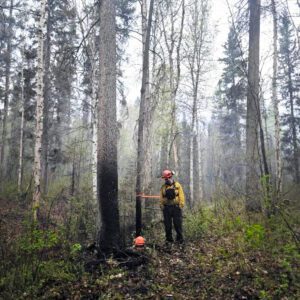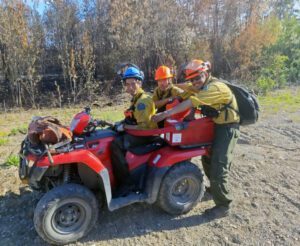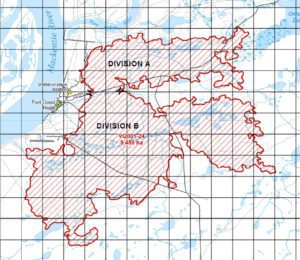There are currently 17 wildfires in the Northwest Territories, with 12 of them labelled as out of control.
Many of those blazes are small and simply being monitored, but some remain a threat to property or people.

Crew members make their way up a slope at Fort Good Hope. (Photo courtesy of NWT Fire)
The fire at Fort Good Hope, called VQ001, that caused the evacuation of residents, is entering its second week and is “aggressively” burning away from the community of about 500 residents.
The wildfire, caused by an abandoned campfire, has grown to 5,459 hectares (see map below).
Officials have stated an investigation into the origins of the blaze will be conducted once the emergency is over.
NWT Fire stated on Sunday that suppression action will be focussed on the fire perimeter adjacent to the community allowing the fire to naturally burn away from the community to create to fire buffer.
Frank McKay is an information officer with NWT Fire.
“We have reached the time of year when, given the right conditions, aggressive fire weather conditions will typically extend well into the evening with the hot, dry, mainly sunny weather forecasted for the next few days.

Danger trees are marked by a crew member to ensure personnel are working safe in the bush at Fort Good Hope. (Photo courtesy of NWT Fire)
“Aggressive burning today is likely to last through to mid-evening, if not longer on the north to southern half of the fire facing away from the community.
“This type of fire behaviour will create localized smoke in the affected areas.”
The fire last week reached the community boundaries, with no structure loss.
Crews and aerial support continue to work fire perimeter facing community extinguishing hotspots and incursions that escape the fire perimeter.
Crews continue to blackline fire perimeter on community side from the fire’s northern edge to southwestern edge and are making excellent progress.
Crews and aerial support continue with suppression operations at southern end of the airport.
The other fire of note is SS017, located roughly 11 kilometres north of Fort Smith Airport.
This lightning caused fire is approximately 3.5 hectares in size and burning in “heavy fuels,” stated NWT Fire
Airtankers have made drops to reduce fire intensity and ground crews are following up to work to contain it.
Parks Canada provided a helicopter and two fire crews to assist with initial attack.
There are no threats to communities, cabins, or infrastructure at this time, stated NWT Fire.

Crew members sharing a light moment before heading out on the fire line at Fort Good Hope. (Photo courtesy of NWT Fire.)
Winds from the north and drying may lead to visible smoke in Fort Smith.
In the Dehcho region, long-burning fire FS008 is less than one kilometre west of Highway 7 and about 45 kilometres south-southwest of the Fort Simpson Airport
This lightning caused wildfire is currently nine hectares in size.
No communities, or cabins at threat currently and highway access has not been compromised at this time.
NWT stated that ground crews and air support have successfully held the fire, and “are making good progress in establishing a perimeter around the fire and extinguishing active fire at its edge.”
The fire is deep burning and will require hard work to expose and extinguish hotspots over the coming days.
Smoke may be visible for travellers.
And the massive wildfire SS009 has grown to 6,260 hectares on the NWT/Alberta border Hand visible for travellers on Highway 1.
NWT Fire is working with Alberta Wildfire and activities within the NWT are focused on structure protection along Highway 1.
Mike Westwick is an information officer with NWT Fire.
“Firefighters have made great progress in containing the fire and have nearly reached all the way around the north end of it,” he stated.
“That has been done with help from firefighters from Saskatchewan, the Beaufort Delta, and North Slave region, alongside heavy equipment and air support.”
Significant cooling on the east side of the fire has been reported.
Smoke may be visible from Alberta Highway 35 and Highway 1 in the NWT, with fire activity primarily occurring to the west of Highway 1.






